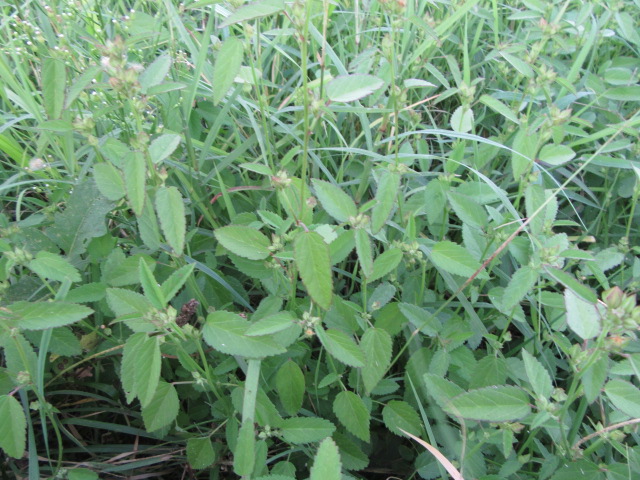
Sida spinosa (Prickly Fanpetals) on 9-1-22, #907-25.
Hello everyone! I hope this post finds you well. You know, time flies when you put things off. Tomorrow seems to come so fast and the next thing you know, weeks have passed! Well, that’s what happened again. I photograph new species I find but maybe some of the photos didn’t turn out very well, so I have to wait until “tomorrow” to take more. Sometimes it is not tomorrow… Then there are “those” plants whose flowers only open in the morning. Well, I am not a morning person, which is another thing I am working on. HA! I have been working on that for a long time. Anyway, on September 1 (yeah, September 1), I needed to go to the hayfield to get photos of the ovaries of the Euphorbia corollata. You read that right, the ovaries. I will post about that later, but the first thing is first. I have to first post about what came first. 🙂
So, I walked through the gate by the barn and headed straight south then after 100′, more or less, I stumbled upon a good-sized patch of a species I hadn’t noticed before. I think the proper word is colony but I am using patch. Neither word really makes botanical sense to me, so I can use either one. I have walked through this area many times and hadn’t noticed them. In a way, I can understand that if the plants are shorter than the grass and everything is green. The only way to notice is if something unusual catches my eye. Sometimes you may find a species that looks like a different species until it does something weird… At a VERY QUICK passing glance, these plants could possibly remind you of Croton glandulosus (Sand Croton). Mind you, a VERY QUICK glance…
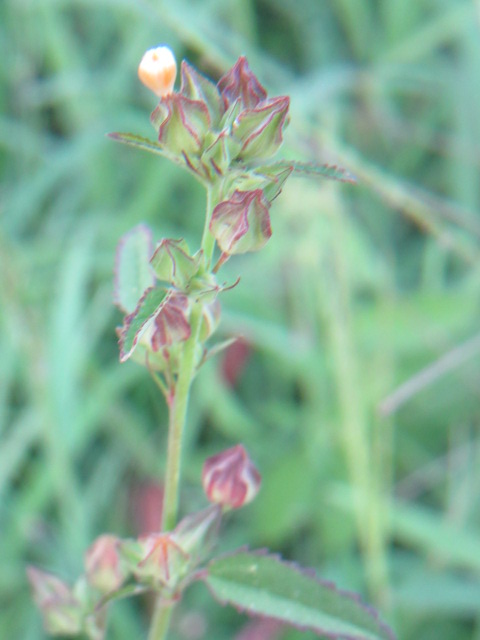
Sida spinosa (Prickly Fanpetals) on 9-1-22, #907-29.
This is what caught my eye… The very small wilted flower was waving like a flag in the breeze! “WHAT IS THAT?!?!” I looked around to see if I could find better flower photos but they were all wilted. And there was A LOT!!!
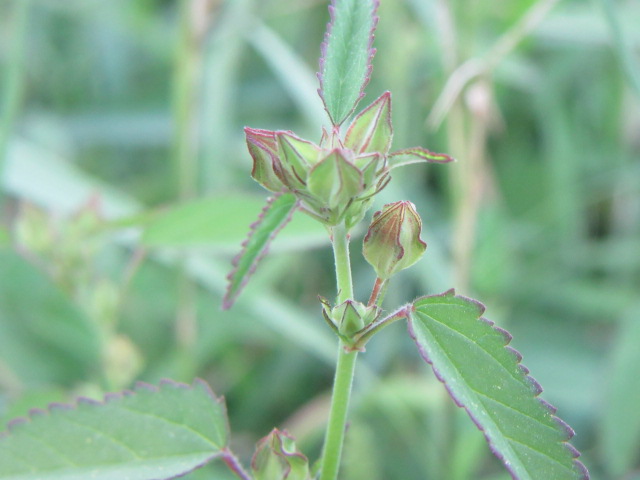
Sida spinosa (Prickly Fanpetals) on 9-1-22, #907-30.
So, are those weird pods buds or fruit? Hmmm… Well, I took enough photos to get an ID on iNaturalist. It is Sida spinosa… Of course, you already know from the captions, huh? The preferred common name on some sites is Prickly Fanpetals, but other common names include False Mallow, Indian Mallow, Prickly Mallow, Prickly Sida, Spiny Sida, Teaweed, Thistle Mallow, White Broomweed, and possibly others.
I looked up the species on the Missouri Plants website and found out Sida is an unusual genus in the plant family Malvaceae and scrolled down to look at the flowers. I could have found that out on iNaturalist, but my habit is always to check on Missouri Plants (since I am from Missouri) and old habits are hard to break.
Flower photos would have been great because they are particularly weird… Well, like I said before, time flies. Missouri Plants says they flower from June through October so I had plenty of time…
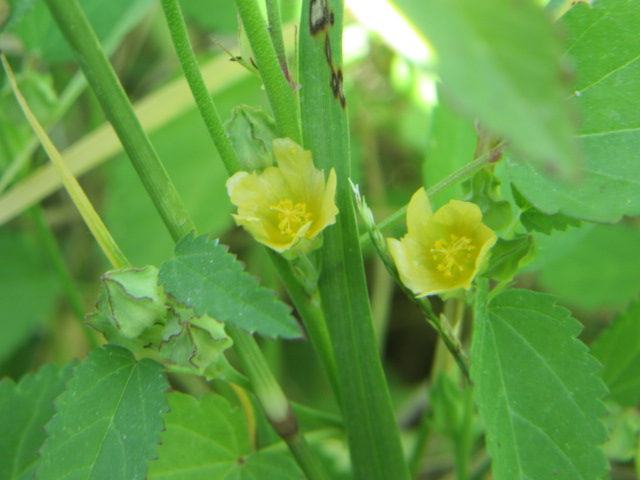
Sida spinosa (Prickly Fanpetals) on 9-14-22, #911-1.
I finally made it back to the “patch” a little after noon on the 14th. As you can see from the top photo (top two on the plant’s page), the flowers can be hidden lower down inside the plant. In fact, when I went out this time, the flowers on top were already beginning to close and wilt…
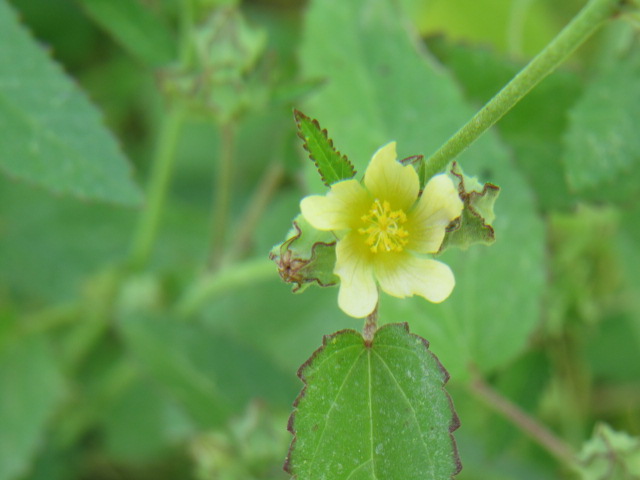
Sida spinosa (Prickly Fanpetals) on 9-14-22, #911-3.
THEN, I finally took this good one. I couldn’t tell if the photos I took were good or not when I was taking them because the sun was bright and the images on the screen weren’t clearly visible. The flowers are very small and I was using a magnifying glass in front of the lens. 🙂
The flowers have a spiral look and the petals are kind of sideways. One side of the petals are longer than the other. How neat is that?!?! The pistol is typical of other members of the family.
When I did my initial research on this species, there wasn’t much at all. Just photos and descriptions. Some sites tell about it as a common weed and how invasive they are in some areas. One thing that caught my eye was how many countries it is considered a native.
I decided to type in “Sida spinosa herbal” and was very surprised. Several Sida species are used by indigenous tribes in South America and other countries for a variety of ailments. Other studies have found out they are good for many other conditions because of its chemical properties. You can read more about this plant, and its contribution to society by going to its own page HERE and scrolling down to the bottom to the links. NOT JUST A WEED! I haven’t written descriptions on its page yet. That is a winter project… 🙂
Now for the other plant on September 2nd… I was headed toward the boundary fence along the front pasture. On the way, I walked through the “patch” of Sida spinosa and stopped DEAD IN MY TRACKS!!! I was shocked at what I had finally found!!!
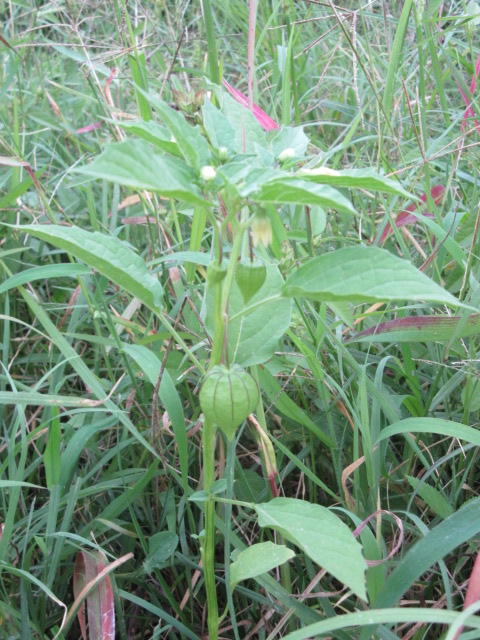
Physalis angulata (Cutleaf Groundcherry) on 9-2-22, #908-20.
HOLY CRAP! I could hardly believe my eyes! Right there in the grass was a single Physalis species. I looked around for more and couldn’t find any. I hadn’t seen any since 2019 when I found a Physalis longifolia (Smooth Ground Cherry) in a friend’s pasture. The one I found and couldn’t find again. Then, in November 2019, I found a plant here east of the chicken house that I supposed was, or had been, P. longifolia. Since it was November, all that was left were a few dead leaves and dried fruit. This plant had been very tall.
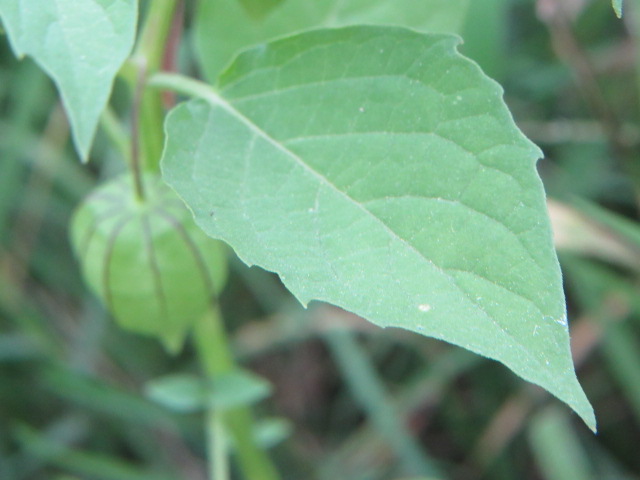
Physalis angulata (Cutleaf Groundcherry) on 9-2-22, #908-23.
The Physalis longifolia looked like a horsenettle, but this new plant didn’t look like that at all. I took photos and uploaded them on iNaturalist for ID. Lo and behold, the new plant is Physalis angulata… Now I am wondering if the dried-up plant that was north of the chicken house was actually the same species. Anyway, I have been looking for them to come up again in the same area, but they never did. The seeds had to go somewhere. I figured unless they had been eaten, they would likely just fall on the ground. I should have picked the husked fruit and planted them myself… Live and learn!
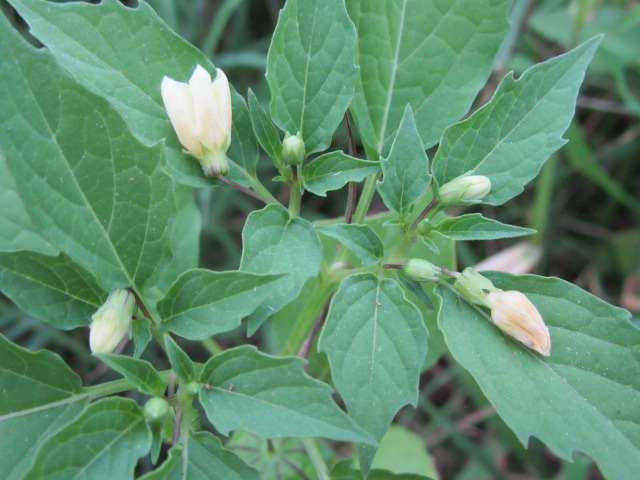
Physalis angulata (Cutleaf Groundcherry) on 9-2-22, #908-21.
Unfortunately, there weren’t any open flowers and it was a little after 7 PM. I would have to go back another day to see if I could take photos of its flowers.
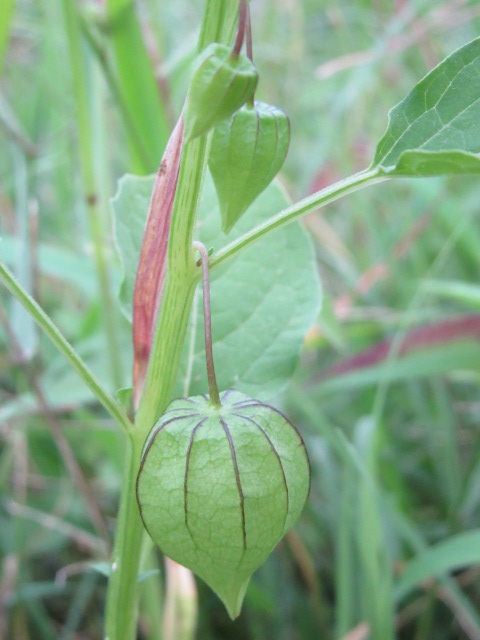
Physalis angulata (Cutleaf Groundcherry) on 9-2-22, #908-26.
Common names for the Physalis angulata include Angular Winter Cherry, Balloon Cherry, Country Gooseberry, Cutleaf Groundcherry, Gooseberry, Hogweed, Mullaca, Sunberry, Wild Tomato, Winter Cherry, and probably others. This species fruit IS EDIBLE! You know, like those husk tomatoes you sometimes see in the grocery store.
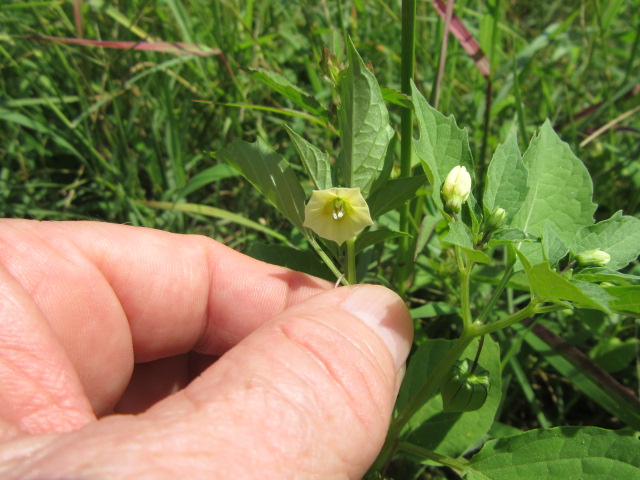
Physalis angulata (Cutleaf Groundcherry) on 9-3-22, #909-1.
I went back to this plant on September 3 at about 1 PM and was able to find one of the flowers open. As you can see in the photo, the flowers are small…
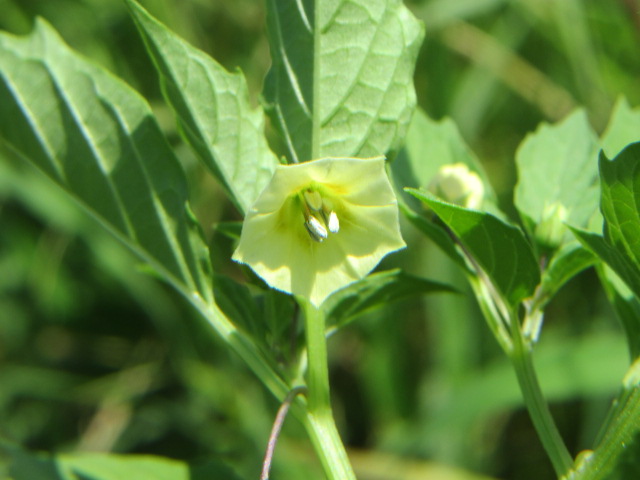
Physalis angulata (Cutleaf Groundcherry) on 9-3-22, #909-2.
The flowers of this particular Physalis angulata have no purple marking around the center, but apparently, they can have.
Interestingly, the Physalis angulata and Sida spinosa have a similar native range in North and South America. Both were used by indigenous tribes in South America.
You can visit the page for the Physalis angulata by clicking HERE and going to the links at the bottom of the page as well.
It is amazing how many wildflowers are used as herbals and even in pharmaceutical medicine. We have definitely learned a lot about rainforest plants from the tribes in South America and the Native Americans in the U.S.
I suppose the next post will have to be about the ovaries of the Euphorbia corollata and what else I found on September 1. Then it’s on to the fence along the front pasture. I need to stop watching episode after episode of Game of Thrones and get to work. 🙂
Until next time, be safe, stay positive, and always be thankful. The temps are cooling off nicely, so it is a great time to GET DIRTY. The only problem is the day length is getting shorter. No putting off until tomorrow. 🙂 Take my advice, I am not using it. 🙂